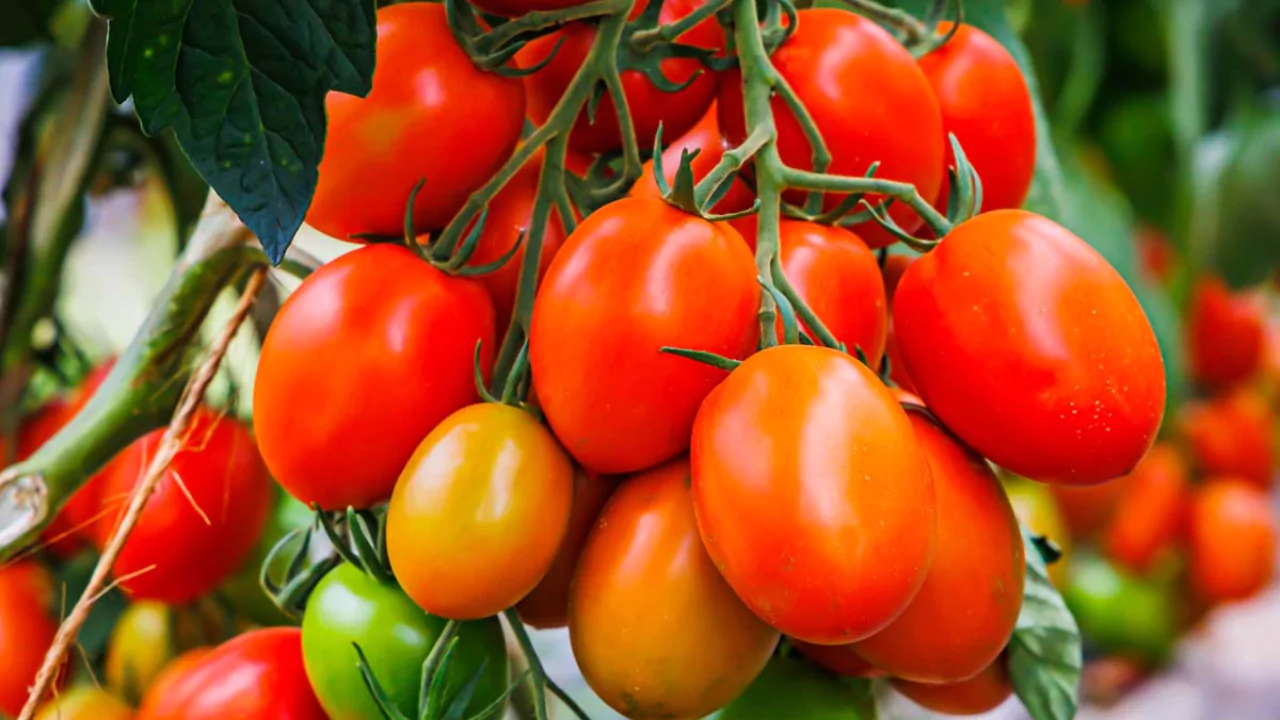
Tomatoes rank as the third most popular vegetable in the United States, following potatoes and lettuce, and most Americans encounter them in cooked forms-ketchup, tomato paste, marinara, and salsa.
Roma tomatoes, often called Italian or plum tomatoes, dominate those cooked products.
These thick-fleshed, oval fruits-red or yellow-are lower in juice and seeds than standard slicing tomatoes. When heated, they reduce to a rich, hearty sauce, a quality that makes them the processors preferred fruit.
Best of all, Romas offer solid nutrition for very few calories. A cup delivers only 37 calories yet supplies generous amounts of vitamin C (34.38 mg), vitamin A (1121.40 IU), and vitamin K (14.22 mcg).
Recent studies have uncovered even more reasons to include Roma tomatoes in the diet. Research shows that processed tomato products are packed with lycopene-a phytochemical linked to lower cancer risk and better heart health. Keep reading to discover these benefits in detail.
Nutritional Benefits of Roma Tomatoes
Cancer Protection.
Studies conducted at Ben-Gurion University of the Negev in Be-er-Sheva, Israel, found that when scientists exposed cancer cells to lycopene, the compound triggered the production of protective enzymes within the tumor cells themselves.
Research shows that people who eat plenty of cooked tomatoes or tomato sauces seem to lower their risk of breast, colorectal, prostate, lung, and pancreatic cancers. Even individuals already living with cancer tend to do better when tomatoes feature prominently on their plates.
The gain does not appear when people rely only on store-bought lycopene pills. Scientists believe dozens of other plant compounds in tomatoes work together like a team, boosting the fruit’s protective power.
Anti-inflammatory.
Leave your bicycle out in the rain and moisture plus oxygen slowly reduces it to rust. Inside your body, a similar chain of free radicals and oxygen tears at cells until oxidation sets in.
Inflammation is the emergency signal your body sends to fight those radicals, yet if the alarm never shuts off, it can fuel heart trouble, Alzheimers, brittle bones, and some cancers.
Tomato products tamp down oxidation and lower inflammation markers, as a report in the Journal of Agricultural and Food Chemistry notes. Simply drinking one glass of tomato juice a day slashed those markers by roughly 35 percent within thirty days.
Heart Health.
Tomatoes supply solid amounts of potassium, niacin, folate, and vitamin B6, all proven helpers for keeping the heart healthy. Researchers have repeatedly shown that people who eat plenty of tomato products tend to see drops in blood pressure and cholesterol levels, along with overall better cardiac fitness.
In one long-term study at Brigham and Womens Hospital in Boston, investigators tracked a group of volunteers for seven years. Those who included tomato items seven to ten times a week faced nearly a 29 percent lower chance of developing heart disease compared to those who rarely consumed them.
Choosing Tomato Products
So skip the French fries drenched in ketchup and the greasy pizza slices. Instead, try Roma tomatoes or rich tomato sauces briefly cooked in a splash of olive oil or a small pat of real butter. Because lycopene dissolves in fat, adding even a little helps the body absorb far more of the antioxidant.
Studies confirm that a drizzle of oil over a tomato dish noticeably raises the amount of beneficial compounds the digestive tract takes in.
Additionally, researchers working with the USDA Agricultural Research Service report that very dark red, organically grown tomatoes contain the highest concentrations of lycopene overall. For example, one tested organic ketchup was measured at an impressive 183 micrograms of lycopene for every gram of the sauce.
A widely used ketchup served in many fast-food outlets delivers just sixty micrograms of lycopene per gram. In contrast, organic tomato products typically offer higher nutrient levels while remaining free of pesticides and high-fructose corn syrup.
Using Roma Tomatoes
Purchase Roma tomatoes during their peak season, or cultivate your own in a small garden. Because Roma plants are determinate, they grow to a manageable size and set fruit over a short, predictable window. Many varieties are bred for disease resistance, making them one of the easiest types of tomato to cultivate successfully.
Roma tomatoes make kitchen work easy. Drop clean, whole tomatoes into boiling water for just thirty seconds. Their skins loosen and slide right off. Chop the peeled fruit, place it in a bowl or pitcher, then store it in the fridge overnight.
As the tomatoes chill, their juice pools at the top; lift and discard that liquid if you want a thicker filling. Puree the fruit or add it whole to onions, peppers, and chiles for bright salsa, or blend it with garlic and basil for classic marinara. You can also toss the peeled chunks into a slow cooker and let them steam for up to eight hours.
The result is a deep, spreadable paste. If your garden overflows, set aside a batch for winter. Freeze the sauce in flat zip-top bags, or jar whole tomatoes and process them in a water-bath canner.
Although they shine when cooked, Romas taste great raw in summer salsas, tomato-feta salads, or hearty sandwiches.
Pair fresh wedges with torn basil, creamy mozzarella, and a drizzle of oil, then spoon the mix onto crusty bread or toss it with pasta. Scatter slices into a broccoli slaw with pine nuts, or savor them solo with nothing but oil, crackling pepper, and a pinch of salt.
Canned meals gain brightness when you fold in freshly chopped Roma tomatoes; stir them into soups, sloppy joes, or stews. A couple spoonfuls of tomato paste also delivers deep, hearty flavor to a wide range of cooked foods.
For flavor youll love and nutrition you can trust, simply work extra Roma tomatoes into your everyday menus.